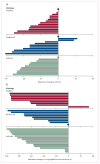Efficacy of pazopanib in progressive, radioiodine-refractory, metastatic differentiated thyroid cancers: results of a phase 2 consortium study
- PMID: 20851682
- PMCID: PMC3107731
- DOI: 10.1016/S1470-2045(10)70203-5
Efficacy of pazopanib in progressive, radioiodine-refractory, metastatic differentiated thyroid cancers: results of a phase 2 consortium study
Abstract
Background: Chemotherapy has historically proven ineffective in advanced differentiated thyroid cancers, but the realisation that various tyrosine kinases are activated in the disease suggested a potential therapeutic role for tyrosine-kinase inhibitors. We investigated the safety and efficacy of pazopanib.
Methods: This phase 2 trial was done from Feb 22, 2008, to Jan 31, 2009, in patients with metastatic, rapidly progressive, radioiodine-refractory differentiated thyroid cancers. Each patient received 800 mg continuous pazopanib daily in 4-week cycles until disease progression, drug intolerance, or both occurred. Up to two previous therapies were allowed, and measurable disease with radiographic progression in the 6-month period before enrolment was a requirement for inclusion. The primary endpoint was any tumour response, according to the Response Evaluation Criteria in Solid Tumors 1.0. This study is registered with ClinicalTrials.gov, number NCT00625846.
Findings: 39 patients were enrolled. One patient had received no previous radioiodine therapy and another withdrew consent before treatment. Clinical outcomes could, therefore, be assessed in 37 patients (19 [51%] men, median age 63 years). The study is closed to accrual of new patients, but several enrolled patients are still being treated. Patients received a median of 12 cycles (range 1 to >23, total >383). Confirmed partial responses were recorded in 18 patients (response rate 49%, 95% CI 35-68), with likelihood of response lasting longer than 1 year calculated to be 66%. Maximum concentration of pazopanib in plasma during cycle one was significantly correlated with radiographic response (r=-0·40, p=0·021). 16 (43%) patients required dose reductions owing to adverse events, the most frequent of which (any grade) were fatigue (29 patients), skin and hair hypopigmentation (28), diarrhoea (27), and nausea (27). Two patients who died during treatment had pre-existing contributory disorders.
Interpretation: Pazopanib seems to represent a promising therapeutic option for patients with advanced differentiated thyroid cancers. The correlation of the patient's response and pazopanib concentration during the first cycle might indicate that treatment can be individualised to achieve optimum outcomes. Assessment of pazopanib in an expanded cohort of patients with differentiated thyroid cancer, as well as in cohorts of patients with medullary and anaplastic thyroid cancers, is presently being done.
Funding: National Cancer Institute, supported in part by NCI CA15083 and CM62205.
Copyright © 2010 Elsevier Ltd. All rights reserved.
Conflict of interest statement
The authors declared no conflicts of interest.
Figures




Comment in
-
Kinase inhibitors for refractory thyroid cancers.Lancet Oncol. 2010 Oct;11(10):912-3. doi: 10.1016/S1470-2045(10)70226-6. Epub 2010 Sep 17. Lancet Oncol. 2010. PMID: 20851683 No abstract available.
Similar articles
-
Real-World Efficacy and Safety of Multi-Tyrosine Kinase Inhibitors in Radioiodine Refractory Thyroid Cancer.Thyroid. 2021 Oct;31(10):1531-1541. doi: 10.1089/thy.2021.0091. Thyroid. 2021. PMID: 34405734
-
An International Phase 2 Study of Pazopanib in Progressive and Metastatic Thyroglobulin Antibody Negative Radioactive Iodine Refractory Differentiated Thyroid Cancer.Thyroid. 2020 Sep;30(9):1254-1262. doi: 10.1089/thy.2019.0269. Epub 2020 Jul 29. Thyroid. 2020. PMID: 32538690 Free PMC article. Clinical Trial.
-
Intermittent versus continuous administration of pazopanib in progressive radioiodine refractory thyroid carcinoma: Final results of the randomised, multicenter, open-label phase II trial PAZOTHYR.Eur J Cancer. 2021 Nov;157:153-164. doi: 10.1016/j.ejca.2021.07.029. Epub 2021 Sep 9. Eur J Cancer. 2021. PMID: 34509954 Clinical Trial.
-
Pazopanib: the newest tyrosine kinase inhibitor for the treatment of advanced or metastatic renal cell carcinoma.Drugs. 2011 Mar 5;71(4):443-54. doi: 10.2165/11588960-000000000-00000. Drugs. 2011. PMID: 21395357 Review.
-
Lenvatinib - A multikinase inhibitor for radioiodine-refractory differentiated thyroid cancer.J Oncol Pharm Pract. 2018 Jan;24(1):28-32. doi: 10.1177/1078155216680119. Epub 2016 Nov 18. J Oncol Pharm Pract. 2018. PMID: 27856921 Review.
Cited by
-
Intramedullary spinal cord metastasis arising from papillary thyroid carcinoma: A case report and review of literature.Surg Neurol Int. 2016 May 17;7(Suppl 13):S375-9. doi: 10.4103/2152-7806.182544. eCollection 2016. Surg Neurol Int. 2016. PMID: 27274413 Free PMC article.
-
New agent to treat advanced or metastasized thyroid cancer, its efficacy, safety, and mechanism.Thorac Cancer. 2015 Jul;6(4):539-43. doi: 10.1111/1759-7714.12238. Epub 2015 Feb 17. Thorac Cancer. 2015. PMID: 26273412 Free PMC article.
-
New Treatment Options for Metastatic Thyroid Cancer.Fed Pract. 2015 Aug;32(Suppl 7):21S-26S. Fed Pract. 2015. PMID: 30766126 Free PMC article.
-
Phase 2 study of vascular endothelial growth factor trap for the treatment of metastatic thyroid cancer.Cancer. 2019 Sep 1;125(17):2984-2990. doi: 10.1002/cncr.32046. Epub 2019 Jun 7. Cancer. 2019. PMID: 31174237 Free PMC article. Clinical Trial.
-
Refractory thyroid carcinoma: which systemic treatment to use?Ther Adv Med Oncol. 2018 Jan 23;10:1758834017752853. doi: 10.1177/1758834017752853. eCollection 2018. Ther Adv Med Oncol. 2018. PMID: 29399055 Free PMC article. Review.
References
-
- American Cancer Society. Cancer facts & figures 2009. Atlanta: American Cancer Society; 2009.
-
- Chen AY, Jemal A, Ward EM. Increasing incidence of differentiated thyroid cancer in the United States, 1988–2005. Cancer. 2009;115:3801–07. - PubMed
-
- Hayat MJ, Howlader N, Reichman ME, Edwards BK. Cancer statistics, trends, and multiple primary cancer analyses from the surveillance, epidemiology, and end results (SEER) program. Oncologist. 2007;12:20–37. - PubMed
-
- Jemal A, Siegel R, Ward E, Hao Y, Xu J, Thun MJ. Cancer statistics, 2009. CA Cancer J Clin. 2009;59:225–49. - PubMed
Publication types
MeSH terms
Substances
Associated data
Grants and funding
LinkOut - more resources
Full Text Sources
Medical

